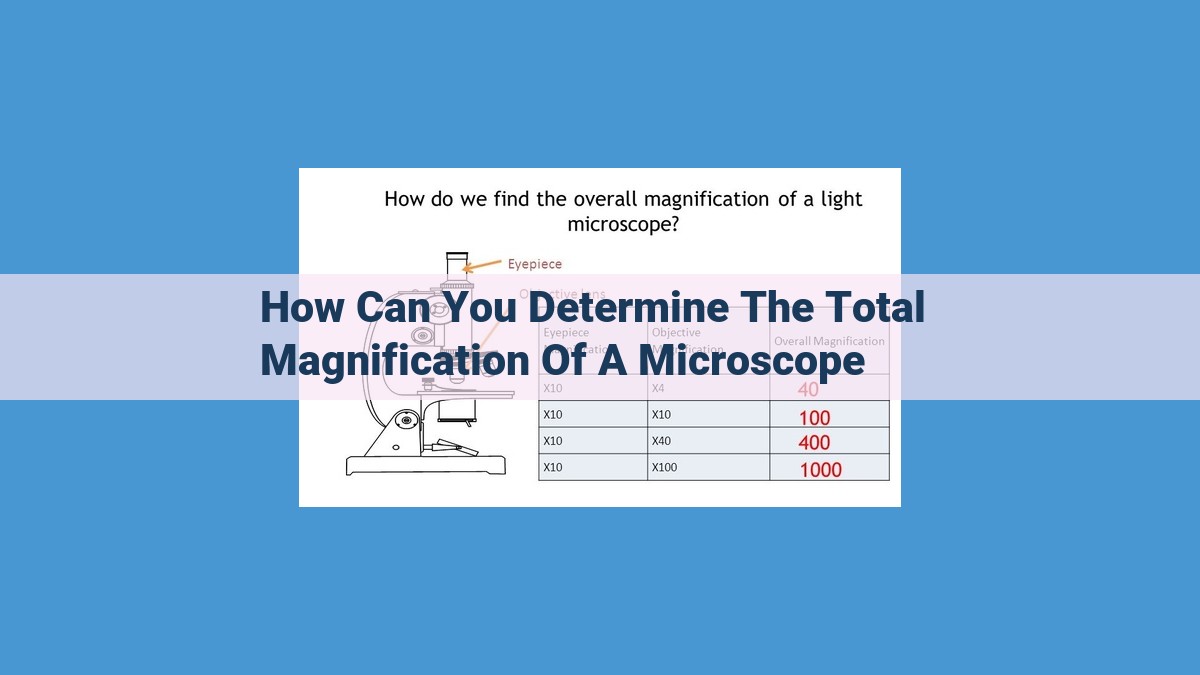To determine the total magnification of a microscope, consider both the eyepiece and objective lens magnifications. The eyepiece lens provides the final magnification, typically engraved on its side. The objective lens, located closer to the specimen, provides initial magnification with varying factors available. Total magnification is calculated by multiplying the eyepiece and objective lens magnifications. Understanding these factors is crucial for choosing the appropriate magnification for specific observations.
Eyepiece Magnification: The Final Touch
In the realm of microscopy, eyepieces serve as the final piece of the magnification puzzle. Nestled atop the microscope, they act like magnifying lenses, amplifying the image created by the objective lens.
Eyepieces typically bear an engraved magnification factor, such as “10x” or “15x.” This factor reflects the additional magnification they provide beyond the initial zoom of the objective lens. It’s like zooming in on a digital camera – the eyepiece allows us to fine-tune the level of detail we observe.
Objective Lens Magnification: The Initial Zoom
Before light reaches the eyepiece, it must pass through the objective lens. This crucial lens is positioned at the front end of the microscope and serves as the initial magnifying component. Its primary function is to gather light and focus it, creating an enlarged image of the specimen.
Objective lenses come in various magnification factors, typically ranging from 4x to 100x. Each lens is meticulously designed to magnify the image by a specific factor. For instance, a 10x objective lens would magnify the image ten times its original size.
The choice of objective lens depends on the desired level of magnification for the observation. Lower magnification lenses, such as 4x or 10x, provide a broad view of the specimen, while higher magnification lenses, such as 40x or 100x, enable detailed examination of smaller structures.
Magnification Factor: Key Points
- Typically engraved on the objective lens mount
- Indicates the initial magnification provided by the lens
- Contributes to the total magnification of the microscope image
Calculating Total Magnification: The Multiplier Effect
In the realm of microscopy, magnification plays a crucial role in unveiling the hidden details of the microscopic world. Total magnification refers to the combined effect of two distinct components: eyepiece magnification and objective lens magnification. Understanding how these components interact to produce the final magnified image is essential for effective microscopic observations.
The formula for calculating total magnification is straightforward:
Total Magnification = Eyepiece Magnification x Objective Lens Magnification
Each component contributes a specific level of magnification. The eyepiece, located at the top of the microscope, provides the final magnification of the image. The magnification factor of the eyepiece is typically engraved on its barrel.
The objective lens, located at the bottom of the microscope, provides the initial magnification. Different objective lenses have different magnification factors, which are also engraved on their barrels.
By combining the magnification factors of the eyepiece and objective lens, we can determine the total magnification of the microscope. For instance, if an eyepiece has a magnification of 10x and the objective lens has a magnification of 40x, the total magnification will be 400x (10x x 40x).
This multiplier effect allows us to achieve a wide range of magnification levels, enabling us to observe specimens at various scales. By understanding the concept of total magnification, we can select the appropriate eyepiece and objective lens combination to optimize our microscopic observations.
Understanding Magnification: The Key to Clear Observations
In the world of microscopy, magnification is everything. It’s the ability to enlarge tiny objects, making them visible to the human eye. To achieve this, microscopes use a combination of lenses: the eyepiece and objective lenses. Let’s dive into the intricacies of these lenses and their crucial roles in determining the total magnification.
Eyepiece Magnification: The Final Touch
The eyepiece, as its name suggests, is the lens that the observer looks through. Its magnification is typically engraved on the eyepiece itself, often expressed as a number followed by “x”, such as 10x or 20x. The eyepiece magnification is the final touch that further enlarges the image formed by the objective lens.
Objective Lens Magnification: The Initial Zoom
The objective lenses are located at the bottom of the microscope and are responsible for the initial zoom. They have various magnification factors, such as 4x, 10x, 40x, and 100x. The magnification factor indicates how much the lens magnifies the image compared to the original size of the specimen.
Calculating Total Magnification: The Multiplier Effect
The total magnification of a microscope is the product of the eyepiece magnification and the objective lens magnification. This is because each lens contributes to the overall enlargement of the image.
Total Magnification = Eyepiece Magnification x Objective Lens Magnification
Example: Putting It into Practice
Let’s say you have an eyepiece with a magnification of 10x and an objective lens with a magnification of 40x. To calculate the total magnification, we simply multiply the two values:
Total Magnification = 10x * 40x = 400x
This means that the microscope will enlarge the image of the specimen by a factor of 400x.
Understanding magnification is crucial for selecting the appropriate microscope for your observations. By considering the eyepiece and objective lens magnifications, you can ensure that you have the necessary magnification to clearly view the features of your specimen.
